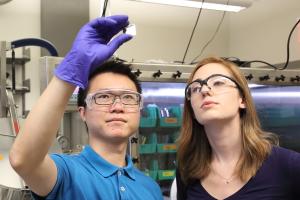Materials Engineering & Nanotechnology Research

Core Faculty

David L. Green
Our group focuses on the synthesis of well-defined nanoparticles, their dispersion into polymer solutions and melts, and their suspension rheology. With our fundamental studies, we seek to optimize processing to achieve a desirable microstructure in industrial suspensions, and to set a foundation for developing constitutive rheological models.

Jason Bates
Bates research group synthesizes catalysts with well-defined structures and use quantitative kinetic measurements and characterizations of their active centers to elucidate structure–reactivity relationships.

Gary Koenig
We are interested in the tailored synthesis of new materials at multiple length scales. At the molecular scale, the physical properties of materials are largely dependent on the stoichiometry and stable structures that can be formed.

Geoff Geise
Geoffrey M. Geise is an associate professor at the University of Virginia with appointments in chemical engineering and materials science and engineering (by courtesy). At UVA, his research focuses on studying the fundamentals of chemically- and electrochemically-driven small molecule transport in polymeric membranes for clean water and energy.

Joshua J. Choi
Joshua Choi joined UVa in 2014 and is a recipient of a NASA Early Career Faculty Award (2015). His research group is developing novel and advanced synthetic methods to achieve robust heterostructure formation, surface structure and impurity doping. They seek to understand and control the structure-property relationships in these materials.

Kyle J. Lampe
Kyle Lampe is an Associate Professor in the Department of Chemical Engineering at the University of Virginia, and by courtesy, Biomedical Engineering and Neuroscience.

Steven R. Caliari
The Caliari Lab designs, synthesizes, and characterizes new biomaterials to explore the dynamic interplay between cells and their microenvironment, applying these platforms to address fundamental human health challenges in understanding disease and engineering tissues.

Rachel A. Letteri
Research Labs
-
Polymer Nanocomposites and Interfacial Engineering in the Green Group
Designing Catalyst Active Centers and Microenvironments in the Bates Group
Nanomaterials and Nanocomposites in the Koenig Group
Advanced Polymer Membrane Materials Research in the Geise Group
Semiconductor and Nanoparticle Research in the Choi Group
Designing Biomaterials to Direct Cell Fate in the Lampe Group
Metal Organic Frameworks Crystal Growth in the Giri Group
Engineering Natural Polymeric Biomaterials in the Caliari Group
Engineering Adaptive Polymer Biomaterials in the Letteri Group


